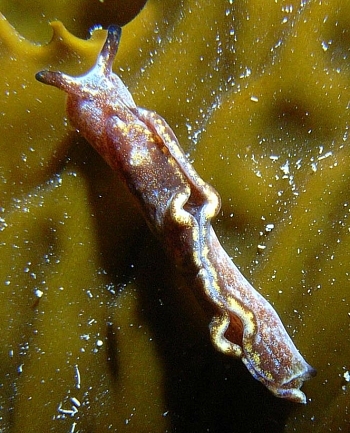
Elysia furvacauda
Burn, 1958
Order: SACOGLOSSA
Superfamily: ELYSIOIDEA
Family: Elysiidae
DISTRIBUTION
Known only from southeastern Australia
PHOTO
Indented Heads, 2 metres, Victoria, Australia, Port Phillip Bay, 24 June 20006, shallow reef. Length: 15 mm. Photographer: Trevor McMurrich.
Described from a single specimen from Victoria, Australia, no photograph of the living animal has been available until now so it has not been possible to clearly define the species. A similar 'species' from New South Wales, Australia has been shown to change colour considerably during its life cycle, as it changes algal food [see Elysia cf. furvacauda] further compounding the identity of Elysia furvacauda.
The attached photo matches the original description in most regards. It differs in having milky yellow patches along the mantle edge rather than the white in Burn's description which is copied below:
"Typical Elysia. Body limaciform. up to 19 mm. in length; parapodia narrow, extending along cither side of body for more than three-quarters of total length. When closed together, the parapodia form two distinct holes along the mid-dorsal line; the anterior hole is nearly the width of the body in diameter, while the other is much smaller; rhinophores large, auriculate slightly involute. Anus emerges a little to the right of the median-line on the anterior edge of the pericardium, which is medianly placed just behind the anterior edges of the parapodia. Body colouring is dark red-brown, outer sides of parapodia speckled with numerous small pale blue spots.The parapodia margins, when together, form a blue mid-dorsal line outlined on either side by a line of interrupted white. Margins of holes plain white; upper anterior portion of each parapodia greyish-blue. Slender neck, pale pinkish-brown; base of the rhinophores and the neck spotted with white dots. Rhinophores and tail tipped with black.
Locality: Torquay (1 spec., Sept. 1957).
Station: Unique, under stone at mid tide.
Remarks: While under observation this specimen showed certain colour changes over a period of 24 hours. The colours noted above were those when first collected. After 24 hours the body-colour was dull brown, with many more larger blue spots on the sides than previously; the anterior blue patch had become very intense. Unfortunately, after two days the specimen died, and when placed in spirits became pale pink, still with black tips, hut with no trace of blue..... "
Note: There are a number of NW Pacific species with similar colouration. See Kathe Jensen's message #4796 discussing E. japonica and E. flavomacula, and Nishina Masayoshi's photos of colour variability [#6704].
-
Burn, R.F. (1958) Further Victorian Opisthobranchia. Journal of the malacological Society of Australia, 2: 20-36. (pls. 6-7)
Rudman, W.B., 2006 (July 15) Elysia furvacauda Burn, 1958. [In] Sea Slug Forum. Australian Museum, Sydney. Available from http://www.seaslugforum.net/factsheet/elysfurv
Related messages
-
Another Elysia furvacauda from S.E.Australia
From: John Chuk, July 19, 2006 -
Rediscovery of Elysia furvacauda from SE Australia
From: Trevor McMurrich, July 17, 2006
